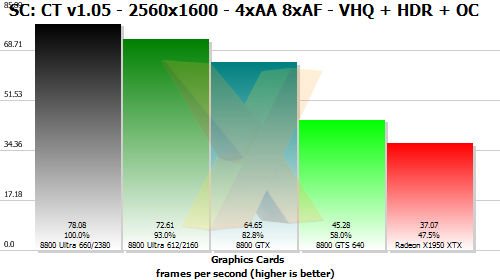Overclocking, power draw, heat
Overclocking
So how well does NVIDIA's claim of process/silicon enhancement stack up? The simple method is to overclock the Ultra and see if it runs past regular air-cooled GTX overclocked core speeds that top out in the vicinity of 625MHz.
The good news is that it does go higher. Our sample was stable at 660MHz core and 2380MHz memory. That's an impressive overclock on both fronts which leads to a further 7.5 per cent performance increase in our 2560x1600 SC:CT HDR test.
Power requirements
It's difficult to solely isolate the graphics card when evaluating power requirements. What we've done is to take the complete system's power requirement and report the idle and peak figures below. The GeForce-based systems' performance can be directly compared against one another as all other components are identical. The Radeon X1950 XTX runs on an Intel i975X platform such that the platform may add/lower the system requirement as compared to the NVIDIA nForce 680i's.We ran both idle and peak measurements, with the latter representing the wattage draw from Test 3 from 3DMark05 (1920x1200 4xAA 16xAF) run on one core and Prime95 torture on the other.
| Graphics Cards | NVIDIA GeForce 8800 Ultra 768MiB | NVIDIA GeForce 8800 GTX 768MiB | ASUS EN8800GTS/HTDP/640M 640MiB | Sapphire Radeon X1950 XTX 512MiB |
|---|---|---|---|---|
| Idle system draw at mains | 185W | 166W | 154W | 119W |
| Idle draw at system, assuming 80% PSU eff. | 148W | 133W | 123W | 95W |
| Peak system draw at mains | 331W | 293W | 251W | 271W |
| Peak system draw at system (80% PSU eff.) | 265W | 234W | 201W | 217W |
The peak-load results are interesting. According to our trusty watt meter, the GeForce 8800 Ultra consumes around 30W more than the GTX, with the numbers derived from an otherwise identical system.
NVIDIA claims the power consumption is lower for the Ultra, and we've confirmed that our sample featured the A3 stepping, so this particular result will require further testing and verificiation.
One plausible reason for this apparent spike in power could be attributed to NVIDIA speed-binning parts for certain frequencies alone. That means you may receive a super-clocked GTX core that operates at the stated 612/1500 speeds, or you may be a recipient of a 'real' Ultra GPU, that is, one with a better power profile through the aforementioned enhancements. It seems as if NVIDIA guarantees the clocks but not the reduced power.
The burning issue?
So just how hot does it get when compared to similar cards?| Graphics cards | NVIDIA GeForce 8800 Ultra (air-cooled) | ECS N8800GTX-768MX (air-cooled) | ASUS EN8800GTX AquaTank (low fan speed) | ASUS EN8800GTX AquaTank (high fan speed) |
|---|---|---|---|---|
| Ambient temperature | 23°C | 21°C | 18°C | 18.5°C |
| Idling temperature | 61°C | 64°C | 51°C | 48°C |
| Load temperature | 87°C | 84°C | 62°C | 59°C |
| Ambient-to-load temperature difference | 64°C | 63°C | 44°C | 40.5°C |
The Ultra's heatsink performs pretty well, and much in line with the reference heatsink on a GeForce 8800 GTX. We wonder just how much lower temperatures would have been if the Ultra core featured the enhanced power profile. Whatever the case, it doesn't come close to matching the performance of the watercooled ASUS EN8800GTX AquaTank proposition, but that's to be expected.









